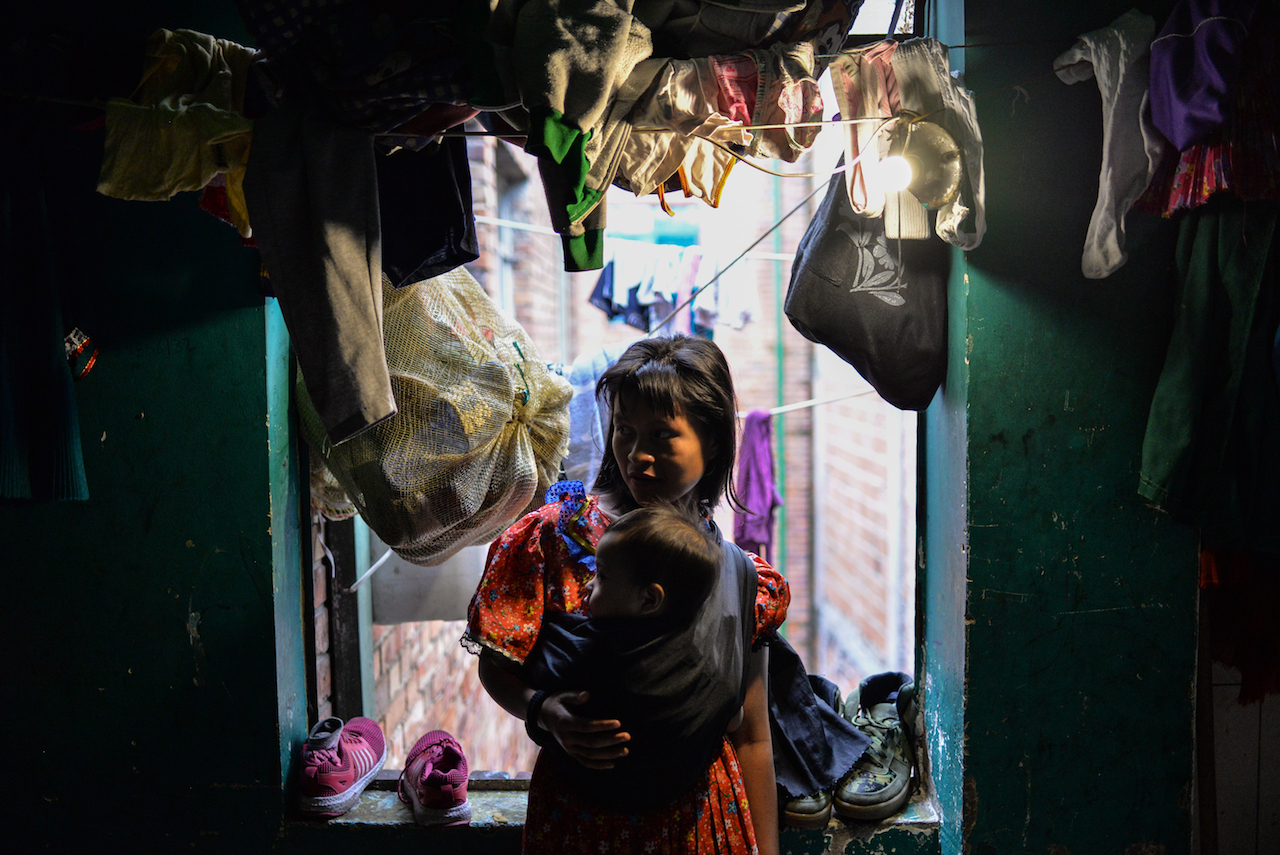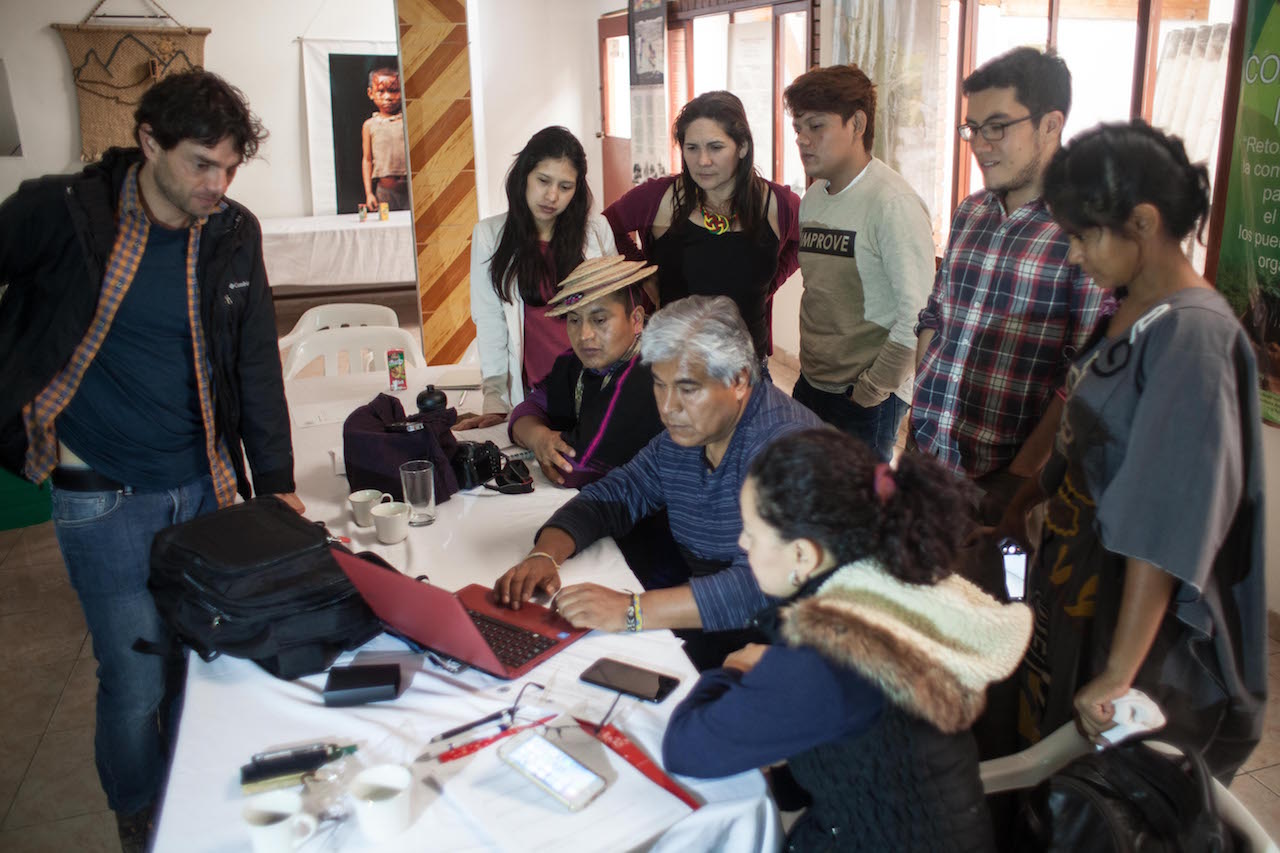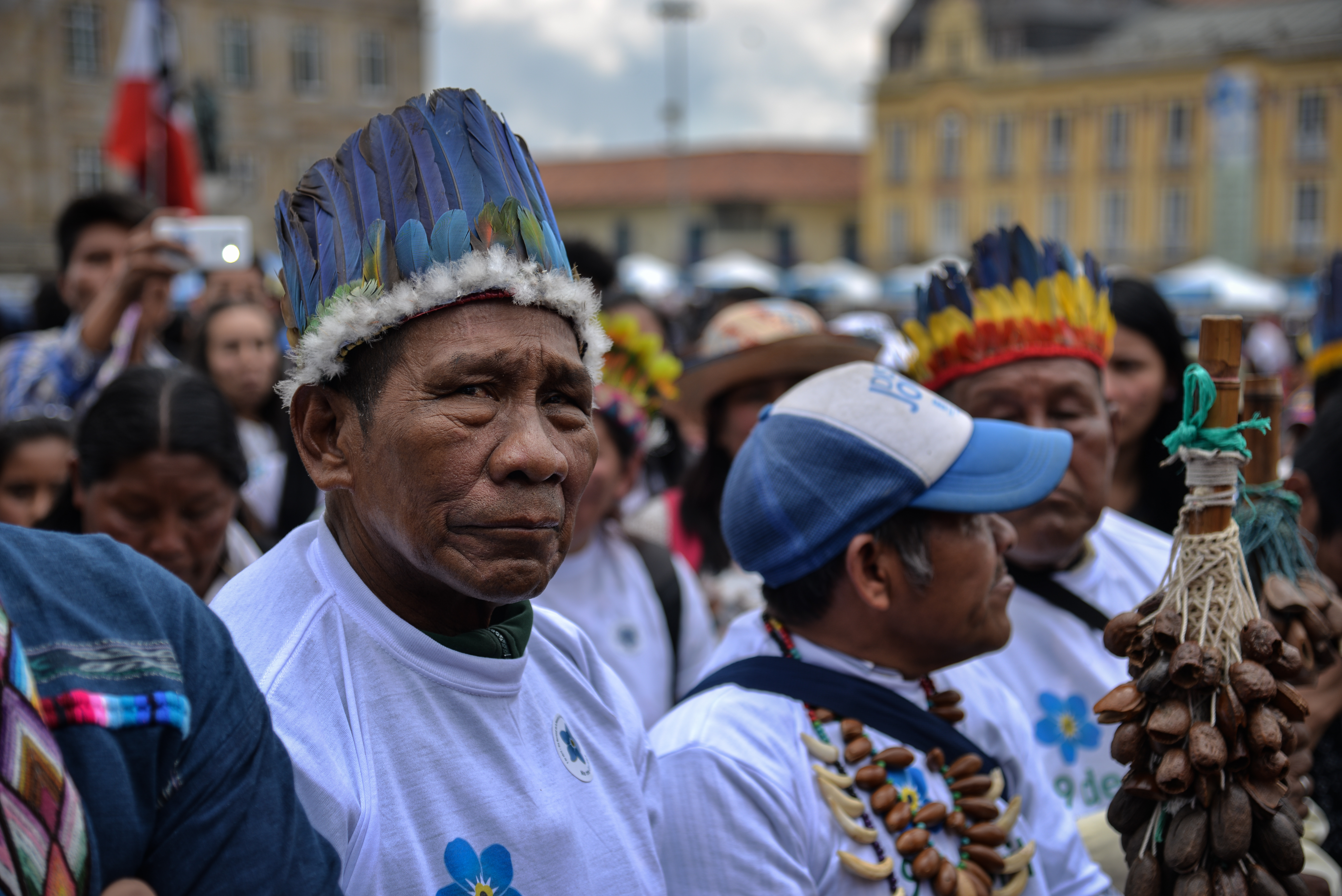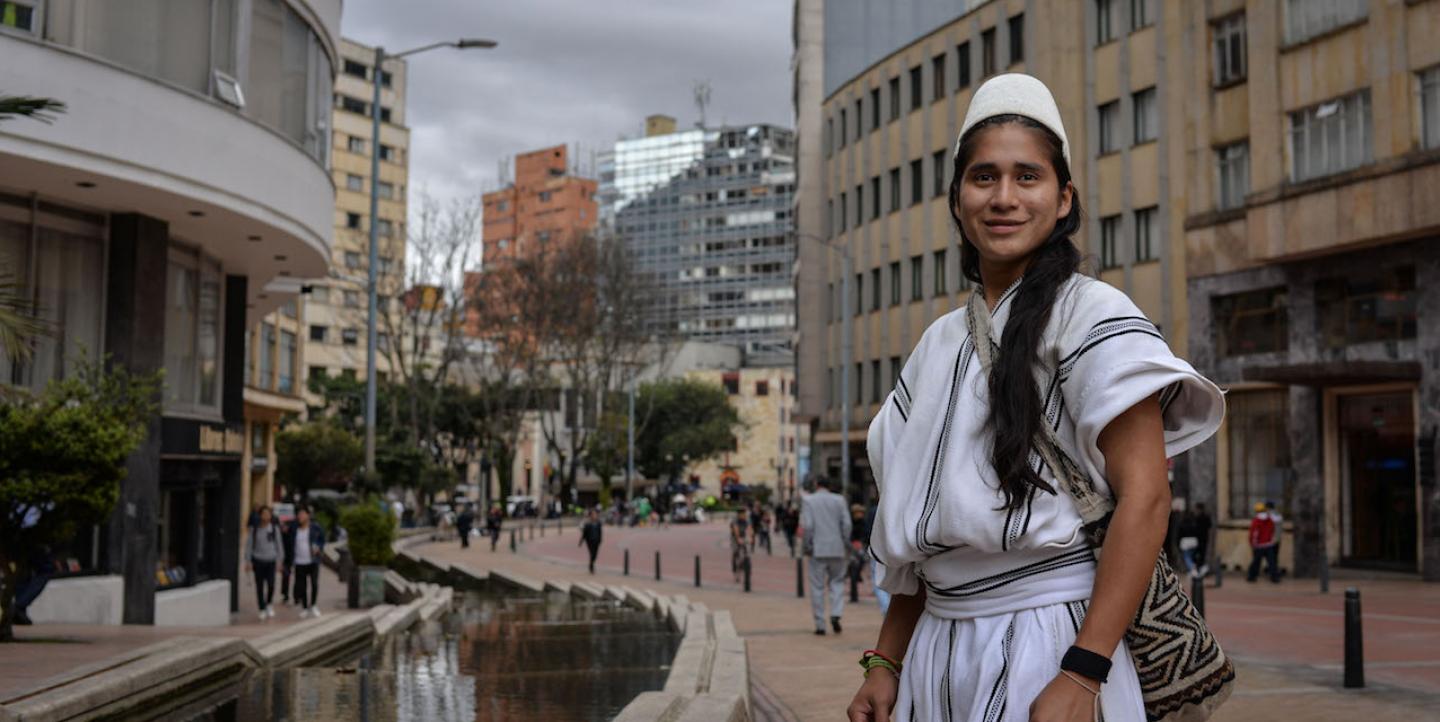In 2018, independent news outlet Agenda Propia brought together a team of editors, journalists and documentary photographers in Colombia to create a space to tell the stories of the more than 37,000 Indigenous people who live in the country’s capital, Bogotá. These Indigenous peoples left their land — in the mountains, rainforest and desert — because of the cruelties inflicted upon them by five decades of armed conflict, land-related issues, poverty and lack of opportunities.
The team, including eight Indigenous and non-Indigenous journalists, went in-depth over four months to find the stories, faces and experiences of the ethnic groups that have been made invisible by the hustle and bustle of a city with more than eight million inhabitants.
Through collaborative workshops and open participation sessions they determined the topics and identified subjects for the project “Indigenous Bogotá.” The online portal they created includes stories, interviews, portraits, photos, documentaries and videos.
The first story provides context about the parallel world that Indigenous communities occupy within Colombia’s major city. In Bogotá, 14 peoples or ethnic groups, of the 102 that are recognized by the country, have created their own councils — traditional socio-political organizations — to earn legal recognition from the Capital District.
The second story examines the forced displacement of 12,200 Indigenous people that brought them to Bogotá between 2002 and 2017, as they sought to escape the violence.
The third story centers on the Embera people, an ethnic group of more than one thousand people who have fought hunger, overcrowding and misconceptions since the early 1990s.

Within these stories, a number of themes emerge, including the leadership role of Indigenous women, the life experiences of young people who straddle two worlds — one of their roots the other of urban life — the condition of the labor force and the role of Indigenous guards within the city.
Lessons learned
The initial challenge for the reporters was to understand two distinct viewpoints: the Indigenous worldview and that of journalists. With that in mind, the reporters held meetings and knowledge exchanges that enabled them to better understand the realities of Indigenous communities.
Later they developed editorial guidelines that served as a roadmap for their reporting: report and write about the stories with respect and dignity, visit the neighborhoods where Indigenous peoples build their community customs, consult a diverse range of sources, request public information and identify the unique characteristics of each ethnic group.
José Navia Lame, the editor of the project, highlighted the participation of Indigenous colleagues and affirmed that their insights enabled more balanced reporting. “We struck a balance between the interests of the communities and those of the journalists, reaching agreements that gave these reports the look of a documentary, but with a journalistic hook,” he explained.
He also recommended that reporters should not generalize about Indigenous communities, given that there are many different Indigenous cultures. Their respective customs and the connections they make with the land differ depending upon their place of origin, including the Andes, rainforest or desert.
To make the process more collaborative, journalists structured the interviews as a conversation, rather than a traditional interview. “Initially it wasn’t easy to have a dialogue due to the diversity of perspectives, but as the weeks went by, the process improved,” said journalist Juan Pablo Tovar.

The reporters learned that to cover stories about this population it’s important to familiarize oneself with the social hierarchies and how they function. In Colombia, oftentimes councils and assemblies represent Indigenous communities. There are also leaders or traditional authorities who are authorized by their community to act as spokespeople, providing information on their behalf.
“If you’re going to begin reporting it’s better to first receive permission from the governing council in order to then be able to speak with the Indigenous communities, or to enter their territory,” said Navia. “You need to respect these hierarchies, which differ across ethnic groups.”
Diana Jembuel, who spoke on behalf of the Misak del Cauca people, explained that in order to engage the communities, one must respect their customs. “Within the journalistic community, time is limited, but for Indigenous communities time is longer,” she said. “They need to know you’re with them. [You need] to walk, to try to adopt the language that they speak and to understand them.”
For this type of reporting it’s very important to build trust, according to Willander González Palmar, a representative of the Wayuu de la Guajira ethnic group. “We Indigenous peoples are not very open to the western world — to white people. We are very closed off in order to protect what we know,” he said. “There are journalists who visit us, do their work, and never return again. Later we realize that they told people things that were untrue. Therefore, it’s important to maintain a dialogue.”
Photographer Luis Ángel recommended that in order to set the scene, one has to take time and exercise caution. “It’s critical to let things happen and build connections,” he said. “If you achieve this closeness you can get a real image or photograph that is dignified and respectful of the community’s privacy.”
The Indigenous Bogotá reporting initiative was made possible with the support of the Organization of American States (OAS) and its Open Government in the Americas Fellowship. It also benefited from the assistance of editors from the Connectas platform and communications staff from the National Indigenous Organization of Colombia.

More guidelines for reporters narrating the Indigenous experience
On the site of Agenda Propia there is a manual with recommendations for covering stories related to Indigenous themes — an area in which the outlet has specialized. The guidelines include:
- Review the national legislation and international law that relate to Indigenous communities.
- Learn the unique norms of each village, ethnic group and community.
- Put together a list of Indigenous and non-Indigenous sources. This is important for giving voice to other actors and presenting balanced reporting.
- Carry out group interviews.
- Understand the symbols, rituals and beliefs. The shared understandings and histories of these peoples are expressed in their objects, fabrics, writings, songs and more.
- Ask Indigenous peoples how they want to be identified, as this dignifies their customs and provides accurate information.
- Provide the historical, social, geographic and cultural context of each unique ethnic group.
- Make a glossary to understand the meaning of unique terms pertaining to each culture.
- Walk through Indigenous lands. This means allocating more time in order to request permission to access certain spaces, and to gain access to people who are authorized to speak on behalf of their community.
Throughout the entire process, journalists — and anyone who seeks to engage Indigenous communities — need to make sure to use respectful language and to avoid any depiction “exoticism and folkloric visions,” said Fabio López de La Roche, a journalism and communications expert at the National University of Colombia.
Main image shows a young university student from the Arhuaco community in Bogotá. All images courtesy of Luis Ángel / Agenda Propia.
Edilma Prada (email) is a Colombian journalist. She has worked for 15 years covering the history of armed conflict, peace, human rights, the environment, ethnic minorities, and the border region. She coordinated the “Bogotá Indígena” initiative and directs Agenda Propia. She has participated in collaborative journalism projects with Indigenous groups and colleagues from other parts of Latin America. In the Colombian Amazon she is currently carrying out a consultancy for the Environmental Investigation Agency (EIA) and she is an instructor for DW Akademie.

